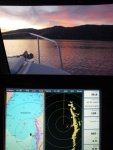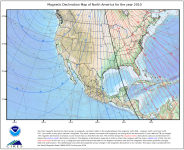Oh great, this could be another twins / singles style. (Well I knew there would be differences) For me, with everything printed (charts) using North up, or True north, it seems easier to use that for a standard.
What brings this up is that I am running into a situation where my auto pilot is having a hard time finding which way to go, and it is apparently from having more than one directional input. This may be due to different "rates of output" from more than one GPS and direction sensor (flux gate compass) getting a signal into the AP somehow (possibly via the MFD.)
So for now, I'm thinking I want to be sure everything is all looking at the same "north", and for me, if they will, they should be all saying the same signal, "North is True".
Boris, thanks for the excellent explanation. You are right, they both will work --> "
It's sorta like twin vs single engines; both will move and steer the boat. The correct one is the choice made for a specific boat by the owner."
Barry, I like the Course Up for the plotter as well. I'm curious, why do you want, and what do you use the verification of declination for?
Digger, I have the plotter set at "true" and the compass has been at magnetic. I have not been as good about keeping that reciprocal setting because I have kept a small, handheld Garmin working with a tracking feature going. It has 12 hours of battery backup should the electric power fail. (Of course if that happens, I may have more to worry about than which way to go.)
Vern, If all is set on Magnetic, that should work well.
Thanks for the feed back. I'm still curious as to the "logic" of why the choices are made. If there is a particular reason for your choice (ie: it makes it easier to follow on a paper chart, or this is the only option between the GPS and my MFD that works.)
Barry likes options. Frankly that would confuse me, but it works for him and he gets from point to point well. Digger likes the true because it lines up on paper with the lat/long lines.
Thanks again,
Harvey
SleepyC :moon



